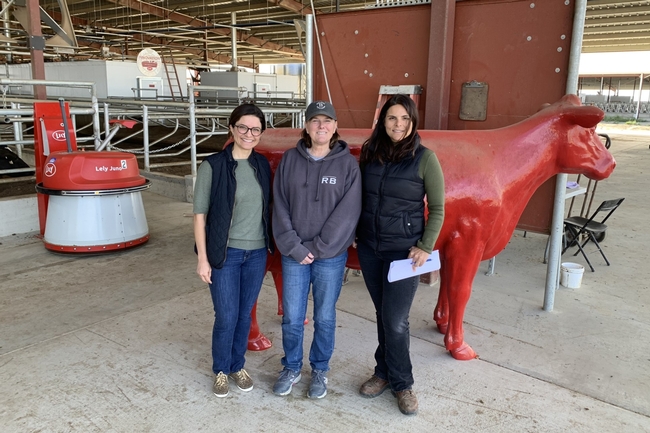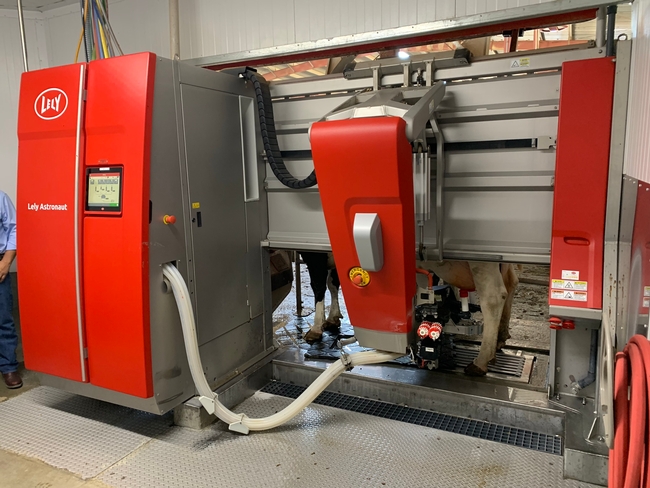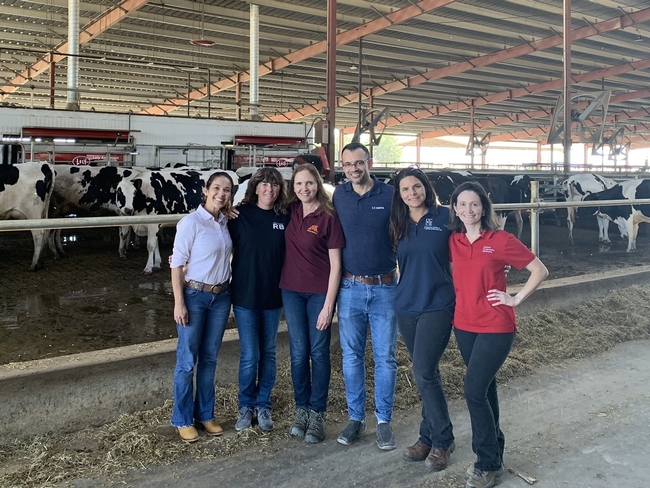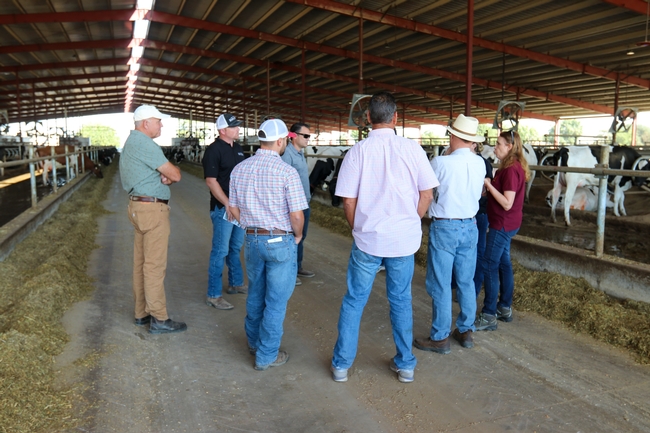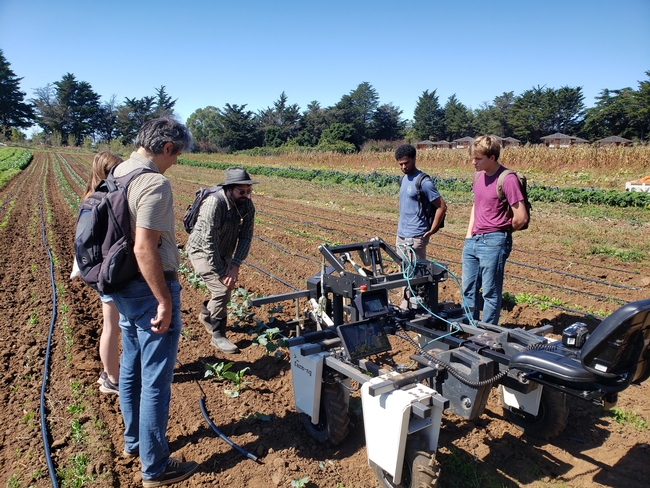Posts Tagged: robotics
Students design high-tech solutions through Farm Robotics Challenge
Award-winning teams announced at FIRA USA robotics conference
A robot that navigates and weeds row-crop fields – and its design team from Olin College of Engineering in Massachusetts – have garnered the grand prize in the second annual Farm Robotics Challenge. Five winning teams, representing various universities and colleges across the U.S., were announced on Oct. 24 during a ceremony at the FIRA USA robotics conference in Woodland (watch recording).
A total of nine teams competed in the Farm Robotics Challenge, organized by University of California Agriculture and Natural Resources and the AI Institute for Next Generation Food Systems (AIFS), with support from technology partner farm-ng.
During the yearlong contest, the students engaged with growers about their pain points and challenges and then developed creative solutions using the farm-ng Amiga robot platform.
“It's inspiring to see the creativity and dedication of these students, who put in a lot of hard work and long hours to pull together some truly remarkable projects for this competition,” said Gabriel Youtsey, chief innovation officer at UC ANR. “We hope the challenge attracts more students to consider careers in agriculture; we're here to help build a supportive community to grow that pipeline to the workforce.”
Providing a platform for students to demonstrate innovative design, field testing and evaluation, and real-world problem solving, the Farm Robotics Challenge is sponsored by F3 Innovate, Beck's Hybrids, California Tomato Research Institute and the United Soybean Board.
“It's a great day when engineers, marketing and technology folks understand there are great opportunities to create products for American farmers,” said Brad Fruth, director of innovation at Beck's Hybrids. “It has been exciting for Beck's Hybrids to participate in this challenge and see the bleeding edge of where technology and agriculture converge.”
The student teams leveraged AI, machine learning, automation, coding and fabrication to advance innovation in agriculture.
“Not only does the challenge demonstrate the future of farming with robotics, but it's also encouraging the next generation of engineers to focus their talents on the challenges that exist in growing our food,” said Brendan Dowdle, CEO of farm-ng. “The students who participate have a unique mix of skills in robotics, software and a passion for the future of agriculture.”
Grand Prize Winner: PhoenixBot, Olin College of Engineering, an autonomous mechanical weeding systembuilt to navigate through row-based crop fields of seedling to early-stage crops to effectively remove weeds from the beds
Team Advisor: Kenechukwu Mbanisi
Students:
Summer Crew/Leads: Jeffrey Woodyard, Dokyun Kim, AJ Evans, Toby Mallon, Brooke Moss
Subteam Leads: Dexter Friis-Hecht, Joe Leedy, Maya Adelman, Dominic Salmieri, Chang Jun Park, Akshat Jain
Team Members: Bill Le, Dongim Lee, Felix Halaska, Bhargavi Deshpande, Elisa Camacho, Cooper Penkava, Marcellus Smith, Rohan Bendapudi, Darian Jiminez, Ivy Mahncke, Quinn Verrill, Sam Wisnoski, Oscar Bao, Mia Chevere, Shauna Sperou
Excellence in Productivity: Florabot, Auburn University, a robot designed to autonomously navigate through nursery plant beds collecting imagery data for plant counting and quality assessment
Team Advisor: Tanzeel Rehman
Students: Hamid Syed, Faraz Ahmad, Mesbahul Maruf, Mohtasim Hadi, Carter Freeman
Excellence in Small Farms Technology: Bin Haulers, Washington State University & Heritage University, a precision agricultural robotic system designed for efficient bin-picking and placement in apple orchards
Team Advisors: Manoj Karkee, Safal Kshetri
Students: Dawood Ahmed, Syed Usama Bin Sabir, Divyanth L.G., Priyanka Upadhyaya, Achyut Paudel, Robert Barragan, Apol Medrano, Osmar Alvarez, Bethany Navaroo, Salvador Ayala
Excellence in Sustainability: TAMU-NCSU Robotics Team, Texas A&M University & North Carolina State University, a multi-modal proximal data collection system utilizing artificial intelligence to generate height maps for semi-structured row crop fields to aid in effective application of post-emergence herbicide
Team Advisors: Steven Brian Mirsky, Chris Reberg-Horton, Muthu Bagavathiannan
Students: Joe Johnson, Matthew Kutugata, Ruthvik Kanumuri, Wesley Hawkes, Jonathan Herrera, Luke Conran, Sebastian Chu
Excellence in Safety: University of California Santa Cruz, an application that allows a user to view the camera, as well as operate the Amiga robot, without a physical connection
Team Advisors: Dejan Milutinovic, Darryl Wong
Students: Katherine Rogacheva, Milos Suvakovic, Oliver Fuchs, Sam Leveau, Mauricio Chavez
In addition to recognition for their efforts, the Grand Prize Winner was awarded $10,000, and the Excellence in Productivity and Small Farms Technology winners won $5,000 each, while the Excellence in Sustainability and Safety winners won $2,500 each.
Other competitors in the challenge included teams from Cal Poly San Luis Obispo, California State University Fresno, Hartnell College and The Pennsylvania State University.
For more information about the Farm Robotics Challenge, including details on how to participate, visit https://farmroboticschallenge.ai.
Partners unveil first on-farm robotics incubators
Opening in Salinas and Merced in 2025, Reservoir Farms will drive ag innovations in automation robotics
The Reservoir, a nonprofit building tech incubators across California, and partners Western Growers Association, University of California Agriculture and Natural Resources, Merced College, Hartnell College and venture capital firm HawkTower have announced the creation of the first-ever on-farm robotics incubators, Reservoir Farms.
Unveiled during a press conference at the FIRA USA 2024 robotics conference in Woodland, Reservoir Farms are set to open in the Central and Salinas Valleys in early 2025. This pioneering initiative significantly shifts how agricultural technology innovates through real-world testing environments, world-class resources and critical industry partnerships.
California agriculture faces critical challenges, including labor availability and cost, import competition, increased regulation, water scarcity, and climate-related challenges, including extreme weather. These challenges have spurred significant advancements in agricultural precision, automation, mechanization, and robotics in recent years.
Despite advancements, early-stage agtech projects lack critical ecosystem support, like connecting directly with growers, testing and validating their solutions, and accessing dedicated shop space and farmland. These gaps hinder capital efficiency and the development of critical solutions that meet the agricultural sector's needs.
Initial projects at the incubators will focus on early-stage agricultural innovations in automation and robotics, including rovers and drones, that accelerate the development of breakthrough solutions to the opportunities and imperatives faced by California farms producing high-value specialty crops, such as labor shortages, profitability, and adopting climate-smart technologies.
Western Growers Association, a key advocate for advancing agricultural innovation, will provide financial and operational support as an anchor partner.
Anchor educational partners like UC ANR, Hartnell College, and Merced College will play a crucial role in innovation and workforce development, preparing the next generation of agricultural researchers, professionals, and innovators to drive the future of farming in California.
HawkTower, a venture capital firm investing in early-stage startups developing breakthrough innovations for California's environmental and industrial imperatives, is also an anchor partner.
“The launch of Reservoir Farms is a critical step forward in ensuring the future resilience of California's agriculture and across the Central Coast and Central Valley,” said Danny Bernstein, CEO of the Reservoir and managing partner of HawkTower. “By placing incubators directly on the farm, we enable innovators to test, iterate, and scale solutions in real-world conditions as a more immediate path to advance farming communities.”
A new model to incubate agtech innovation
The idea for Reservoir Farms emerged from extensive industry research and consultations with over 50 organizations in the specialty crop sector. Key insights uncovered critical gaps in startups' access to real-world testing environments, shop space, and direct relationships with growers – factors severely hindered capital efficiency and posed a formidable barrier to innovation.
“Our goal is to eliminate the friction points that have historically slowed down the development of new agtech solutions,” said Walt Duflock, senior vice president of innovation at Western Growers Association. “Reservoir Farms offers a new model, where startups can work side-by-side with growers to test their technologies, iterate in a low-stakes environment, and build scalable solutions to improve agriculture's operations.”
Initiative to support thriving agtech ecosystem and job creation
The Reservoir Farms initiative also reflects a broad-based collaboration between key educational institutions, industry players, and local communities to ensure the next generation of agricultural professionals is equipped with the skills needed to support the region's growing agtech sector.
Supporting partners include Central Coast Small Business Development Center (SBDC), Communities Organized for Relational Power in Action (COPA), Digital NEST, Farmhand Ventures, Merced County Farm Bureau, Milano Technical Group, Monterey Bay DART (Drone Automation & Robotics Technology), Monterey Bay Economic Partnership, Monterey County Farm Bureau, Tesserakt Ventures, and The VINE.
“As robotics and automation become more integral to California agriculture, it's essential to have facilities like Reservoir Farms embedded within the farming community,” said Gabriel Youtsey, chief innovation officer at UC ANR. “By bridging the gap between lab-based research and real-world application and accelerating tech transfer, Reservoir Farms can help build the workforce and technology needed to address the critical challenges on the farm, from labor shortages to climate change.”
Focus on specialized services and real-world testing in California's agricultural heartland
Reservoir Farms will open its first two locations in Salinas Valley and Merced in the first quarter of 2025. Participants can lease testing fields and shop space without the burden of multi-year leases, giving them the flexibility needed to scale. The incubators will offer fully equipped R&D workshops, secure storage for expensive equipment, and customized, pre-planted specialty crop fields for testing.
These facilities will be complemented by Reservoir Farms' co-working spaces, meeting rooms, and a robust demo day schedule designed to connect startups with growers, investors, and other key stakeholders.
In addition, the Western Growers Association's validation process will provide startups with a quantitative “scorecard” that offers crucial metrics on scalability, efficacy, and financial viability. This validation, combined with UC ANR's field testing, will help startups refine their products and receive a critical stamp of approval that builds trust with growers and ensures a smoother path to commercialization.
Media Contact:
Jennifer Goldston
AgTech PR for the Reservoir
816-260-0040
jennifer@agtechpr.com
Lawn-pocalypse! Surviving Drought
Ah, summer! The season of sunburns, pool parties, and… lawn droughts. If your once lush, green carpet now looks like a crunchy brown doormat, you're not alone. Let's dive into why your yard is staging a dramatic death scene and what you can do to...

Bermuda grass and weeds overtaking drought stressed turf grass.
UCCE advisor Bruno guides, learns from dairies switching to milking robots
Automatic milking systems increasingly used in California amid labor challenges
When third-generation dairy farmer Shonda Reid first saw a milking robot at a farm show 13 years ago, she immediately recognized that the technology represented the future. Her father, however, took a bit more convincing.
“I came home and showed him and said, ‘This is what we need to do.' And he thought I was kidding!” said Reid, dairy and farm manager for Fred Rau Dairy, which has a herd of 1,400 milk cows in Fresno County.
Years later, after the family had visited several dairies using automatic milking systems (AMS) across the U.S., they installed their first six robots in November 2021. By fall 2022, they had 24 robots, evenly split between two newly built “free stall” barns where the cows can freely go to the milking machines.
As Fred Rau Dairy was one of the first in California to implement AMS at such a scale, Reid and her team have been instrumental in growing practical knowledge on these systems. She also has been a valued partner to Daniela Bruno, University of California Cooperative Extension dairy advisor for Fresno, Madera and Kings counties.
“Automatic milking robots are not a new technology, but it's new to California,” said Bruno, noting that the milking robots were first used on small, family-run farms in Europe, where the technology granted family members more time for rest and other pursuits.
To better understand the feasibility of milking robots for large dairies in California, Bruno – alongside former UC Davis School of Veterinary Medicine professor Fernanda Ferreira, University of Minnesota researcher Marcia Endres and other collaborators – began a project in 2020 to study the risks and opportunities of automated systems.
“The information is extremely useful for California producers to make informed decisions about implementing AMS on their facilities,” said Denise Mullinax, executive director of the California Dairy Research Foundation, which supported the effort through a competitive grant. “Cow care, labor requirements and profitability are key issues for producers, and CDRF was pleased to support this project which assists producers in understanding how AMS may impact those areas on their facility.”
Dairy farmer: ‘We needed to make some changes'
The project produced a paper analyzing existing research on automatic systems, which have been more widely used in the Midwest, where there are more small-scale, family-run dairies. In 2020, there were only 14 “box robots” in California, according to Bruno. Now there are about 200 across California – and both Bruno and Reid cited labor challenges as the primary reason for the increased use of automated systems.
“California suffers from labor quality and quantity issues,” Bruno said. “By bringing robots to California, you can minimize those problems.”
Higher costs of hiring and retaining employees, driven in part by new labor laws, are one factor. And then there's the reliability and availability of labor, as fewer people are willing to do the physically demanding work of conventional milking.
“People just don't want to milk in a flat barn [a conventional setup where the employee works at the same level as the cow] – there's a lot of kneeling, squatting, that type of thing – it's pretty tough on the body,” Reid explained.
Faced with labor shortages and mounting regulatory burdens, Reid said Fred Rau Dairy had to make the leap to automated systems to keep the 80-year-old dairy operation running.
“We needed to make some changes, or we're going out of the dairy business,” she said.
In a survey conducted by Bruno and her colleagues of large dairies using AMS across the U.S., a majority of the 29 respondents reported reductions in labor costs – but survey results did not offer a definitive picture on whether AMS improved bottom-line profitability.
Calmer, healthier cows
Nevertheless, most of the survey respondents said they were generally happy with their transition to automatic systems.
“It's totally met our expectations, and cow health has gotten much better, too,” Reid said.
In a typical conventional system where cows are outside in “open corral” pens, dairy employees must cajole the cows into the milking parlor. But within a “free stall” barn where the cows can voluntarily go to the milking robots when they want, as often as they want, the animals are much less stressed.
“When you think about cow handling, if you have robots, you don't have anybody pushing and screaming at them to walk to the parlor,” Bruno explained. “You have less cow-people interaction so they are more calm; there is less stress.”
In the survey of large dairies using milking robots, more than 90% of the respondents said their cows were calmer. Reid also noted that many people have noticed how calm their cows are in the free stall barns.
“They're not skittish, you can walk in and they don't run,” Reid said. “They'll just watch you or they'll even come up and start licking on your jacket or shirt.”
Bruno also said that many of the large dairies reported fewer cases of mastitis and other diseases, less lameness, and greater milk production. But she added it's hard to know whether the benefits can be attributed to the robots and their real-time monitoring technology – or to changes in the physical environment (cows save energy in the free stall barn setup, versus the open-corral system that requires walking to the milking parlor).
Dairy producers seek counsel on potential transition
Less bovine travel from outside to inside was a boon for Fred Rau Dairy during last year's unusually wet winter.
“Even if it's just a couple of weeks of rain, that mud and manure and everything – you do what you can, but oh my gosh – it's a mess,” said Reid, noting that easier facility maintenance during extreme weather was another benefit of switching to automatic systems within free stall barns.
Reid shared many of her experiences with attendees of an AMS Field Day in October 2022, arranged by Bruno, Ferreira and their collaborators. About 60 farmers, researchers, industry representatives and consultants visited Fred Rau Dairy and Jones Dairy in Merced County.
If a dairy producer is considering implementing automatic systems, Reid recommends that they research all their options, visit dairies that use the systems, and check who in their area would be providing service and technical support.
And there are crucial workforce considerations, as dairy workers must learn an entirely new set of skills and processes. Instead of spending their time fetching the cows, prepping them and milking them in the parlor, workers might need to gather and interpret data from the robots. “Cow people,” as Reid puts it, must become computer people.
“You have a group of people who have been with you for a while, and you hope that they can transition to the new technology of what you're doing,” Reid said.
During this technological transition, and on the myriad other challenges that dairy operators face, Reid said she is grateful for Bruno's expertise and responsiveness.
“If there's something that I need, she's been really good about trying to help – or putting me in contact with the right people,” she explained. “I've enjoyed working with her.”
The AMS project team also includes UC Davis School of Veterinary Medicine professor Fabio Lima, postdoctoral researcher Thaisa Marques and former postdoctoral researcher Camila Lage.
Farm Robotics Challenge launches 2024 college competition
Students must form teams by Oct. 31; proposals due Nov. 15
Registration is now open for college teams competing in the 2024 Farm Robotics Challenge and proposals are due Nov. 15. The collegiate competition is organized by The VINE, an initiative of University of California Agriculture and Natural Resources, in collaboration with farm-ng, F3 Innovate and AI Institute for Next Gen Food Systems.
The Farm Robotics Challenge is an annual event where teams of students from universities and colleges across the United States tackle real-world farming challenges. The competition focuses on small-farm applications and leverages the state-of-the-art Amiga robot to integrate robotics into agricultural research. This year, the challenge is expanding by introducing a new division for two-year colleges, to allow more students to participate.
“The Farm Robotics Challenge is not just another competition; it's a transformative experience designed to cultivate the next generation of leaders in agricultural technology,” said Gabe Youtsey, UC ANR chief innovation officer and founder of The VINE. “By participating in this challenge, students are not only showcasing their technical skills, but also contributing to a larger mission — advancing sustainable and efficient farming practices for the future. We're incredibly excited to see the solutions that these young entrepreneurs will bring to the table.”
Teams are expected to address a variety of production farming topics, which can range from any crop or size of farm. The challenges for the competition are categorized into three main areas: Autonomy, which includes course navigation; Artificial Intelligence, focusing on vision and sensing as well as dataset collection; and Attachment, which involves the development of devices that can be attached to the robot for farm tasks..
“We're proud to join forces with the University of California Agriculture and Natural Resources for the second annual Farm Robotics Challenge," said Ethan Rublee, CEO of farm-ng. "With our Amiga robotics platform, our aim is to not only inspire the next wave of agricultural innovation, but also to prepare the workforce that will bring these innovations to life.”
Judging for the competition will be based on a range of criteria including the accuracy and completeness of the project, the elegance and ease of use in the design, safety measures, interdisciplinary inclusion, societal and economic impact, cost considerations, and the commercial and market potential of the solution.
The competition will consist of two main parts: market research, project proposal and fundraising; followed by development, coding and fabrication. Key dates include:
- Team formation deadline: Oct. 31
- Project proposal submission deadline: Nov. 15
- Development start: Jan. 31, 2024
- Judging: Sept. 6, 2024
Interested students, universities and investors are encouraged to visit the official Farm Robotics Challenge website at www.farmroboticschallenge.ai to fill out interest forms and get involved. The website also features detailed information about the challenges and judging criteria.
About The VINE
The VINE, an initiative of University of California Agriculture and Natural Resources, is California's agriculture, food, and biotech innovation network. Our mission is to harness the power of open innovation to help industries and entrepreneurs grow and scale globally while catalyzing technology innovation and commercialization for productive, sustainable and equitable food systems.
About AIFS
Established on Oct. 1, 2020, the Artificial Intelligence Institute for Next Generation Food Systems, or AIFS, aims to solve the world's biggest challenges to crop and food production facing our planet: ensuring a sustainable, nutritious, efficient and safe food supply while mitigating the impacts of climate change.
About farm-ng
Based in Watsonville, farm-ng is building general purpose off-road robotics hardware and software products. The company's mission is to transform the food system by democratizing access for the smallest farmer to cutting-edge robotics technology.
About F3 Innovate
Headquartered in California's Central Valley, F3 Innovate is the U.S. epicenter for climate-smart agrifood tech. With proximity to over 13,650 farms and 5 million acres of farmland, we collaborate with top research institutions to advance industry research and development. Supported by federal and state funding, F3 Innovate is geared to shape the future of sustainable food production worldwide.









